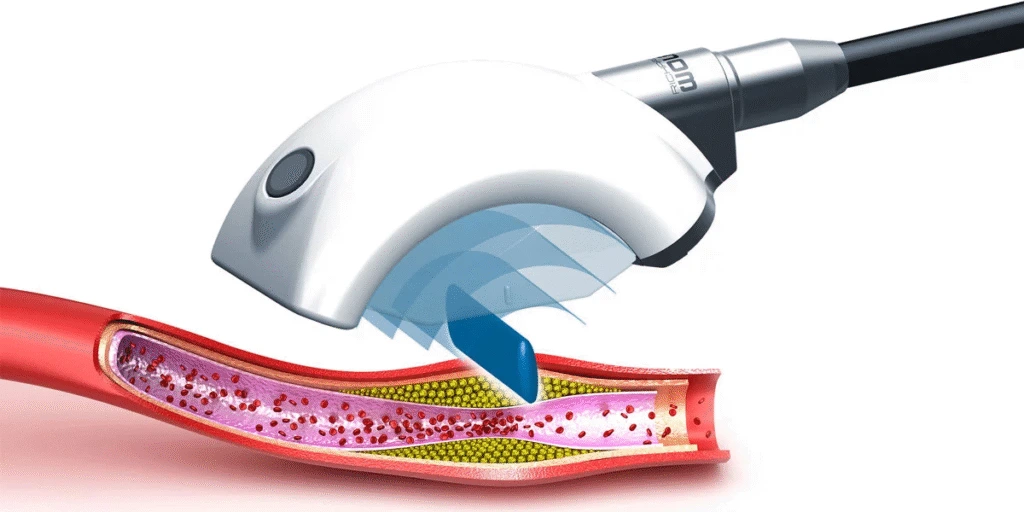What is Shockwave Therapy?
Shockwave therapy, also known as extracorporeal shockwave therapy (ESWT), is a non-invasive medical treatment that utilizes high-energy sound waves to promote healing and tissue repair. Originally developed for treating musculoskeletal conditions like tendonitis, plantar fasciitis, and osteoarthritis, shockwave therapy has found a significant role in urology, particularly for treating erectile dysfunction (ED).
The therapy works by delivering either focused or radial shockwaves to the targeted area. These shockwaves stimulate blood flow, reduce inflammation, and encourage tissue regeneration. For patients with erectile dysfunction, especially those with vascular ED, this increased blood flow can lead to improved erectile function. The treatment is typically painless and can be conveniently performed in a clinical setting, making it an attractive noninvasive treatment option for those seeking non-invasive solutions.
Focused vs. Radial Shockwave Therapy: A Detailed Comparison
At the core of LI-ESWT’s success is its ability to deliver acoustic energy to targeted areas, stimulating angiogenesis (the formation of new blood vessels), nerve regeneration, and tissue repair. However, the method of delivering this energy differs significantly between focused and radial shock wave devices, leading to notable variations in outcomes. LI-ESWT is also recognized as a noninvasive treatment, offering a less intrusive option for those seeking effective therapy.
Focused Shock Waves:
Focused shock wave therapy is characterized by its ability to concentrate energy within a well-defined focal zone. The PiezoWave2 leverages piezoelectric technology, using piezoelectric crystals to generate a high-voltage pulse. This creates shock waves that are concentrated at a precise depth, which can be adjusted to target specific tissues. The precision of focused shock waves allows them to penetrate deeply—up to 100 mm—making them ideal for reaching the erectile tissues in the penis. This targeted approach ensures that the therapeutic energy is concentrated where it is needed most, minimizing energy loss and maximizing treatment efficacy.
Radial Shock Waves:
In contrast, radial shockwave therapy disperses energy over a broader area. Radial devices deliver shock waves in a manner akin to a “jackhammer” effect, which lacks the precise focal targeting of focused devices. While this approach can be beneficial for superficial musculoskeletal conditions such as tendonitis or plantar fasciitis, it is less effective for deeper structures like the erectile tissues. The energy from radial waves dissipates rapidly as it spreads outward, making it less capable of inducing the cellular and vascular changes necessary for improving erectile function.
Why Focused Shockwave Therapy Excels for ED
The physiological changes required to improve erectile function—such as enhanced blood flow, repair of microvascular damage, and nerve regeneration—depend on precise and deep energy delivery. Low intensity shockwave therapy is used to improve erectile function by stimulating blood flow in penile tissue. As a noninvasive treatment, focused shockwave therapy offers significant benefits by providing the depth and accuracy needed to achieve these effects. Focused shock waves, like those delivered by the PiezoWave2, provide the depth and accuracy needed to achieve these effects. They stimulate the release of vascular endothelial growth factor (VEGF) and endothelial nitric oxide synthase (eNOS), both of which play critical roles in promoting blood vessel formation and improving vascular health. These mechanisms are essential for restoring erectile function and overall penile health.

Radial shock waves, on the other hand, often fall short in this context. Their broader energy dispersion can lead to reduced efficacy for ED treatment, as the energy may not reach the deeper erectile tissues in sufficient intensity. This makes them a less suitable choice for addressing the root causes of erectile dysfunction.
Treatment Procedure and Expectations
The treatment procedure for shockwave therapy is straightforward and typically involves the following steps:
- Preparation: The patient is comfortably positioned on an examination table, and the area to be treated is cleaned and prepped.
- Application A conductive gel or oil is applied to the treatment area to facilitate the transmission of shockwaves.
- Treatment: The shockwave device is then applied to the area, delivering the therapy according to a predetermined protocol tailored to the patient’s needs.
- Follow-up: Patients may need to attend follow-up appointments to monitor progress and determine if additional sessions are necessary.
Each session usually lasts between 15 to 30 minutes. The number of sessions required can vary based on the condition being treated and the individual patient’s response. While some patients may notice immediate relief, others might need multiple sessions to achieve the best results. This variability underscores the importance of personalized treatment plans. Additionally, shockwave therapy is a noninvasive treatment, making it an appealing option for those seeking less intrusive methods.
Advantages of the PiezoWave2
The PiezoWave2’s focused shock wave technology offers several unique benefits that set it apart from other devices:
- Customizable Penetration Depths and Energy Levels: The PiezoWave2 allows clinicians to tailor treatments to individual patient needs. By adjusting the depth and intensity of the shock waves, the device ensures precise targeting of the affected tissues, optimizing therapeutic outcomes.
- Promoting Biological Healing Processes: Focused shock waves delivered by the PiezoWave2 stimulate angiogenesis, stem cell proliferation, and nerve regeneration. These biological processes are critical for improving erectile function and achieving long-term results. Studies have demonstrated that focused shock waves significantly increase VEGF and eNOS levels, promoting vascular and tissue health.
- Enhanced Patient Comfort:: The precision of focused shock waves minimizes energy dispersion to surrounding tissues, reducing discomfort and potential side effects. This is particularly important for sensitive areas such as the penis.
- Ease of Use and Advanced Features: The PiezoWave2 is designed with user-friendly features, including app-based guidance and therapy source recognition. These features streamline the treatment process, making it easier for practitioners to deliver effective care.
- Durability and Reliability: Built with high-quality materials and advanced engineering, the PiezoWave2 offers exceptional durability and performance, ensuring consistent results over time.
Additionally, the PiezoWave2 is a noninvasive treatment, making it an appealing option for those seeking less intrusive methods for managing erectile dysfunction.
Evaluating treatment outcomes for specific medical diagnoses is crucial for advancing patient care and improving clinical practice.
Clinical Evidence Supporting Extracorporeal Shock Wave Therapy
A growing body of clinical evidence underscores the superiority of focused shock wave therapy, particularly when delivered using devices like the PiezoWave2. Retrospective studies comparing focused and radial shock wave therapies have consistently shown better outcomes for patients treated with focused shock waves.
For instance, patients undergoing focused shock wave therapy for ED demonstrated significant improvements in key metrics such as the International Index of Erectile Function (IIEF-5) scores and Erectile Hardness Scores (EHS). These improvements were not only statistically significant but also clinically meaningful, indicating a tangible enhancement in erectile function and quality of life. Moreover, the success rates of focused shock wave therapy were notably higher than those of radial therapy, highlighting the importance of precise and targeted energy delivery. However, there is a need for standardized treatment protocols to ensure consistent and effective application of shockwave therapy across various medical conditions. Additionally, radial wave therapy is often promoted as a noninvasive treatment, making it an appealing option for those seeking less intrusive methods.
Candidates and Contraindications
- Individuals with musculoskeletal conditions such as tendonitis, plantar fasciitis, and osteoarthritis.
- Patients suffering from erectile dysfunction, particularly those with vascular ED.
- Those who have not found relief from other treatments like physical therapy or medication.
However, there are certain contraindications to be aware of:
- Active infection or inflammation in the treatment area.
- Pregnancy or breastfeeding.
- Presence of cancer or tumors in the affected area.
- Patients with pacemakers or other implantable devices.
- Recent surgery or trauma in the treatment area.
It’s crucial for patients to discuss their medical history and any concerns with a healthcare professional to ensure shockwave therapy is a safe and appropriate option for them.
Cost and Scheduling
The cost of shockwave therapy for erectile dysfunction (ED) can vary depending on the location, provider, and number of sessions required. On average, a single session can cost between $400 to $500. A typical treatment protocol consists of 6-12 sessions, spaced 1-2 weeks apart. It’s essential to note that shockwave therapy is not currently covered by insurance plans, and patients should be prepared to pay out-of-pocket for the treatment.
Scheduling a shockwave therapy session is relatively straightforward. Patients can start by consulting with a urologist or a healthcare provider who offers shockwave therapy. During the initial consultation, the provider will assess the patient’s suitability for the treatment and discuss the potential benefits and risks. If the patient decides to proceed, the provider will schedule the sessions, which typically take place in an outpatient setting.
Education and Training
Education and training are crucial for healthcare providers who offer shockwave therapy. The American Urological Association (AUA) and the International Society for Medical Shockwave Treatment (ISMST) provide guidelines and recommendations for the use of shockwave therapy in treating ED.
Healthcare providers should undergo comprehensive training, which includes:
- Understanding the principles of shockwave therapy and its applications in urology.
- Familiarity with the different types of shockwave devices and their settings.
- Knowledge of treatment protocols and patient selection criteria.
- Understanding of potential adverse effects and how to manage them.
- Familiarity with the latest research and clinical trials on shockwave therapy for ED.
Patients should also be educated about the treatment, including its benefits, risks, and potential outcomes. This includes understanding the treatment protocol, the number of sessions required, and the expected duration of the treatment.
Risks and Side Effects
While shockwave therapy is generally considered safe, it is not entirely free of risks. Some patients may experience mild side effects, including:
- Mild pain or discomfort during or after the treatment session.
- Swelling or bruising in the treated area.
- Numbness or tingling sensations.
- Rarely, infection or inflammation in the treated area.
Applications Beyond Erectile Dysfunction
While the primary focus of this discussion is on ED, it is worth noting that focused shock wave therapy has applications beyond sexual health. Studies have explored the effectiveness of extracorporeal shock wave therapy in managing spasticity for conditions like spinal cord injury, emphasizing its potential to reduce spasticity and improve functional outcomes. Devices like the PiezoWave2 have been used effectively for treating conditions such as Peyronie’s disease, chronic pelvic pain syndrome, and musculoskeletal injuries. The ability to precisely target tissues and promote healing makes focused shock wave therapy a versatile and valuable tool in various medical fields. It is also recognized as a noninvasive treatment for a range of conditions, appealing to those seeking less intrusive options.
Radial shock wave therapy, while less suitable for ED, retains its utility for more superficial conditions. It is frequently employed in physical therapy and sports medicine for conditions like plantar fasciitis, calcific shoulder tendinitis, and Achilles tendinopathy. However, its limitations in depth and precision make it less effective for conditions requiring deeper tissue penetration.
Future Research and Developments
Research on shockwave therapy for ED is ongoing, and several studies are investigating its efficacy, safety, and optimal treatment protocols. Future research directions include:
- Standardizing treatment protocols and parameters.
- Investigating the long-term effects of shockwave therapy on erectile function.
- Comparing the efficacy of different types of shockwave devices and settings.
- Exploring the potential benefits of combining shockwave therapy with other treatments, such as physical therapy or pharmacological interventions.
- Investigating the use of shockwave therapy in treating other urological conditions, such as Peyronie’s disease or chronic pelvic pain syndrome.
As research continues to evolve, we can expect to see improvements in treatment outcomes, patient selection criteria, and the development of new technologies and devices. Patients and healthcare providers should stay informed about the latest developments and research findings to ensure optimal treatment outcomes.
Conclusion
In summary, Low-Intensity Extracorporeal Shock Wave Therapy (LI-ESWT) has revolutionized the treatment landscape for erectile dysfunction, offering a noninvasive treatment and effective alternative to traditional therapies. Shockwave treatment is generally safe when administered properly, but it is important to be aware of potential complications and the necessity of physician oversight. Within this realm, the choice of technology plays a critical role in determining outcomes. Focused shock wave therapy, as exemplified by the PiezoWave2, stands out as the superior option for treating ED due to its precision, efficacy, and patient comfort.
The PiezoWave2’s ability to deliver deeply targeted energy ensures optimal stimulation of the biological processes needed to restore erectile function. Its customizable settings, advanced features, and proven clinical results make it a preferred choice for both patients and practitioners. While radial shock wave therapy has its place in treating superficial conditions, its broader and less precise energy delivery limits its effectiveness for ED.
For those seeking a cutting-edge solution to erectile dysfunction, the PiezoWave2 represents a best-in-class option, combining advanced technology with a patient-centered approach. Its ability to deeply and accurately target the erectile tissues makes it a powerful tool for achieving lasting improvements in sexual health and overall quality of life.
Peak Masculinity
Starts Here

By Dr. Ryan Welter
August 12, 2025




